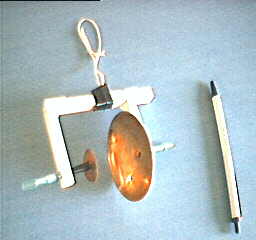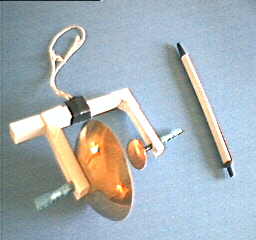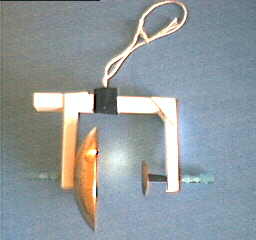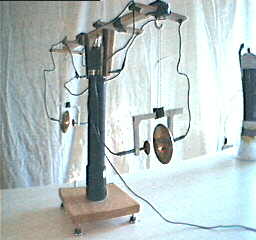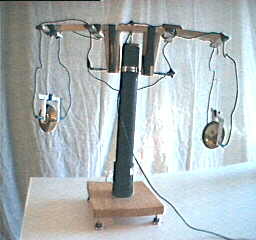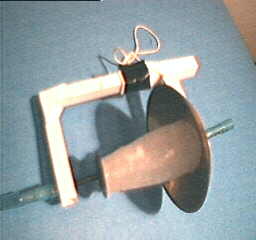This experiment demonstrates a type of electrode combination that almost always moves in the direction of the positive as in the Biefeld-Brown effect. However, it's more likely the effect taking place it some form of ion propulsion/ion wind.
The Basic Device
The basic device consists of two electrodes, a brass dome shaped one of diameter 2 5/8 inches, the other a copper disk of diameter 7/8 inches. The optimum seperation between the two I found to be about 2 1/4 inches. The following three pictures show close ups of this device (note that the seperation in these pictures is about 1 3/4 inches).
|
The Experimental Set Up
The pictures below show two views of the devices suspended from a tower the idea being that when the voltage is turned on, the suspended devices make the rotor rotate.
|
|
Experiments and Results from my Lab Book
I first experimented with this device back in September or October of 1997. The device almost always moves in the direction of the positive electrode.
I say almost always because there were a few times a few years ago, when it would start moving in one direction and then as the voltage was turned up, reverse itself. Once reversed, it would continue in the new direction. It is as if one force were at play until the voltage was high enough for another force to take precedence or take over. Unfortunately, I did not make any notes of which electrode was positive at the time and which direction it reversed into. The only thing I do recall was that it would always occur if and only if a specific electrode was positive (either the dome or the disk) but I can't recall which and can't reproduce it.
It tends to move twice as fast when the dome is positive than when the copper disk is positive.
I also put a cone shapped slug of wax between the electrodes at one time to act as a more massive dielectric with a higher dielectric constant than air. Due to the crudity of my tower and the fact that the amount of friction varies per experiment every time I make an adjustment, I could not determine if this was an improvement. It did, however, continue to move only in the direction of the positive electrode. See the following picture.
|
Conclusions
These devices are perhaps more interesting than the saucer shaped ones as they always move in the direction of the positive electrode (possibly Beifeld-Brown effect) and because of the reversing that happened on a few occasions.
In subsequent years I have seen this behaviour in various ion wind devices. It happens when at relatively lower voltages the ion wind is behaving as expected with the sharp electrode ionizing air and the smoother electrode being attracted to it, with the ionized air reacting by moving in the opposite direction. But at some threshold voltage, insulation in other parts in the system such as at wire connections for example, break down and ionize air causing a reversal of direciton. At high enough voltage I've even seen purplish corona leaking out of seemingly okay insulation along a length of wire that's in close proximity to something of the opposite polarity.

